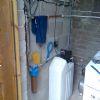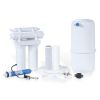Nitrate reduction
Water with high nitrate levels is not recommended for human consumption. It can cause problems, ranging from blue baby syndrome (if fed to babies under six months old) to a build up in the meat of poultry (leading to the meat no longer being white). The source of nitrate in ground water is often from farming fertilizers. The maximum level for potable water is 50mg/l with an advisory of 25mg/l. The first step is to have the water tested; from the results we will be able to advise and design suitable treatment system.
Nitrates dissolved in water cannot be removed by simple filtration. They can be reduced by using an ion exchange system or using a Reverse Osmosis (RO) unit.
In the case of ion exchange the media removes the nitrates (NO4) and also sulphates (SO4) and replaces with chloride (Cl) ions. Like a softener this unit will use salt to regenerate the media and will increase the chloride levels within the water, therefore when specifying we will need to consider the raw water chloride levels.
Reverse Osmosis is often a point of use application (under-sink) and can remove up to 83-92 percent of nitrates in water. Whole house treatment systems are often cost-prohibitive; in some circumstances they are required by the local authority however in other circumstances an under-sink RO can provide a treated dedicated drinking water tap.
| Further information is available | |||
|
|
||
| Related images in this section Click for a larger image and description |
|
|






